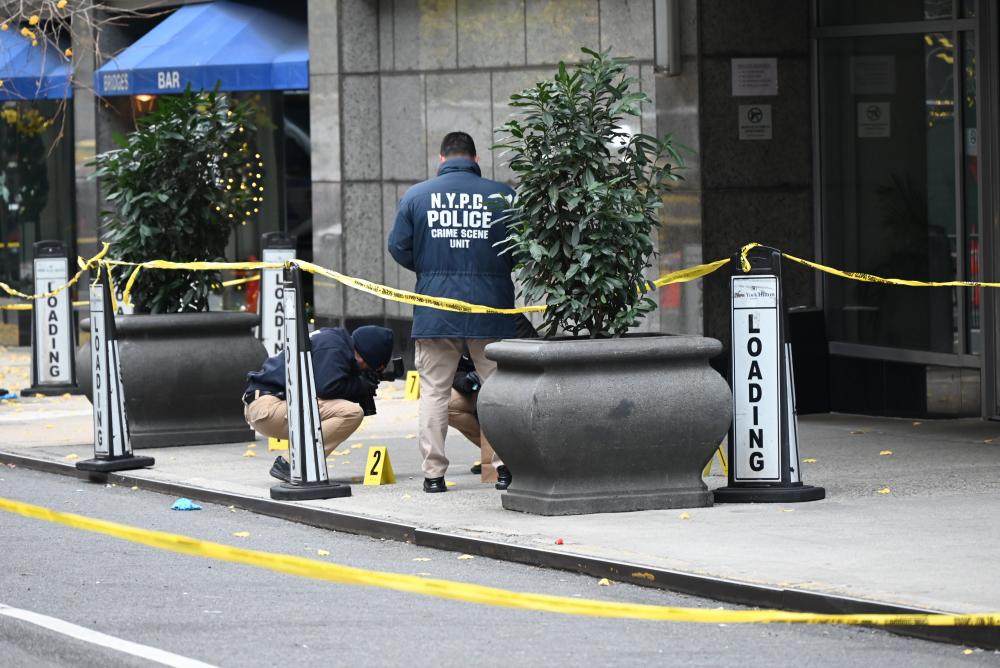On a Wednesday morning, United Healthcare’s CEO, Brian Thompson, was tragically shot outside a Manhattan hotel in a blatant act of violence that quickly raised concerns about his murder’s motives and origins. Surveillance footage captured the suspect’s movements leading up to the attack, showing him exiting a subway station around 6:15 am, stopping at a nearby Starbucks to buy energy bars and water, and then lingering near a deli before heading to the hotel for an investor conference. The gunman, dressed in a brown jacket, face mask, and grey backpack, approached Thompson from behind around 6:30 am before opening fire. Eyewitnesses report that he continued shooting even after his weapon jammed, emphasizing the premeditated nature of the act. He then fled the scene, evading a rapidly set up police operation.
In the aftermath of the shooting, police discovered intriguing evidence that hinted at deeper motivations for the crime. Bullets found at the scene were reportedly inscribed with terms such as “deny,” “depose,” and “defend,” words that closely mirror themes in the 2010 book “Delay, Deny, Defend: Why Insurance Companies Don’t Pay Claims and What You Can Do About It.” This connection has led to heightened speculation about whether the shooting was inspired by a disgruntlement with the healthcare sector or if there were other undiscovered motives at play. In addition to the bullets, police found a water bottle and cellphone in an alleyway, and video surveillance from a hostel showed the shooter removing his mask and smiling at an employee, intensifying the mystery surrounding his persona and intent.
Despite the overwhelming evidence, the gunman remains unidentified and at large, prompting intensive investigations by law enforcement. There are fears that he may have already fled New York City, complicating the pursuit of justice. Speculation regarding the motive of the shooting runs rampant, with comparisons being drawn to other high-profile killings that initially led investigators down incorrect paths. For instance, in the case of Cash App founder Bob Lee, theories that postulated on random violent crime ultimately morphed into a deeper personal conflict. Similarly, the killing of mob boss Francesco Cali raised fears of a mob war, which proved incorrect as it was related to a delusional belief involving Donald Trump.
Experts in criminal investigations express differing views on whether this incident stems from organized crime or a more personal vendetta. Vernon J. Geberth, a former NYPD lieutenant-commander, assessed that the nature of the killing seems highly personal rather than indicative of a professional hit. He noted that although a plethora of clues exists, such as DNA traces on the discarded items, their value is diminished if the shooter is not entered into the law enforcement database. He expressed confidence that with the suspect’s face being widely circulated and a reward offered, someone would ultimately recognize him.
FBI profiler Mary Ellen O’Toole offered insights into the shooter’s behaviors thus far, surmising that he had likely planned this attack meticulously. Notably, the choice of location outside a prominent hotel with multiple exit strategies indicates preparation. Additionally, the use of a suppressor demonstrates forethought in minimizing noise during the firing. O’Toole also highlighted the composure of the shooter, particularly when faced with the malfunction of his weapon. Such steadiness is atypical in high-stress situations, leading her to conclude that this was a targeted attack devoid of conversation, signifying that the intent was cold and calculated.
As the investigation progresses, New York City Mayor Eric Adams expressed optimism about apprehending the shooter quickly, underscoring the methodical efforts of law enforcement in unraveling this case. He acknowledged the complexity of identifying a masked suspect in a city renowned for its stringent policing, emphasizing that this event was undeniably targeted rather than random chaos. While the law enforcement agencies work relentlessly to find leads, the intricate web of motives behind this shocking act keeps the public and analysts alike speculating about its implications for the healthcare industry and broader societal concerns. The investigation continues to unfold amidst rising tension, raising questions about safety and stability in urban settings as unanswered queries linger in the aftermath of Thompson’s untimely death.

